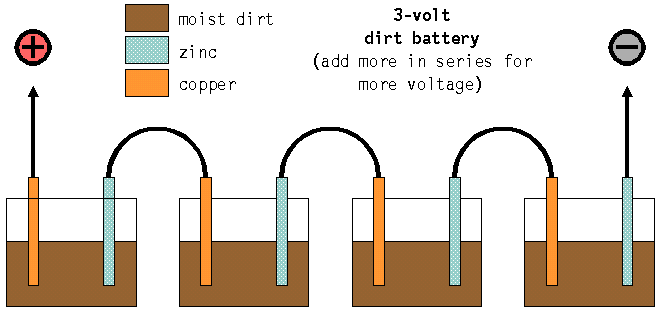
| |
 |
![]()

Dirt makes pretty good batteries. It seems like moist dirt packed tightly works the best. Add just enough water but not too much. I guess if the dirt dries up, you'll have to water the batteries along with the rest of the plants. The soda can version works but I haven't tested extensively. You don't really have to use a penny, just has to be copper. Perhaps other common materials would work better. Each cell gives you a useless 0.5 volts. But if you link them in series you can get more. I was able to light up an LED decently with 4 cells. Not quite as bright as Alkalines, but you get what you pay for I guess. While it's probably not the easiest way to get power, it's basically free, and it works on a small scale. Larger, higher current versions may be possible, but you'll probably need to still connect several together to attain a usable voltage level.
I have the idea of hammering 2 tubes in the ground, a slightly larger alluminum tube with a copper plumbing pipe inside, like this:
_____ / _ \ | (_)-|----copper (+0.75 volts) \_____/----alluminum or zinc (-)
It works just like a regular battery except the electrolyte is damp dirt. And you get a quick recharge with each and every acid-rain. The first dirt batteries I made indoors in paper cups worked almost as good as commercial AA's, so I think the process is scaleable to larger amounts of power. I'm guessing that chaining about 32 of them in series would provide a steady 24 volts at a pretty decent amount of current. Maybe each cell would be 2 feet deep or so. Connect the copper of the first cell to the aluminum of the next, and so on. (Just like AA batteries in the radio) Since it's so simple I thought I'd post the idea in case someone had the stuff laying around and wanted to give it a whirl.
Offered by Joe.
I suspect a good acid soil will work best. If not, urine is acidic.
Offered by Steve.
I think one inside the other may be difficult to hammer in the ground and keep the pipes from touching, causing an electrical short. I suspect one could pick up used copper and zinc plated steel pipes out of wrecked houses after the pole shift. It should work to run the two pipes parallel to each other in a shallow trench near the earth's surface. A good test would be to determine the optimum distance apart to get the most power output for different soils. This would be good data for all to have. We could put an insulator to keep them apart 1/4-1/2 inch, or will 1-2 ft. work just as well? Or can one house be built with copper plumbing and another next to it with galvanized steel being 20-100 ft apart and still have it work without digging up the pipes?
Offered by Mike.